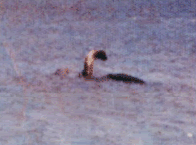
Mansi picture of Champ from Genesis Park
Lake Champlain on the New York-Vermont border was named after Samuel de Champlain, the French explorer that discovered it. So is Champ, its legendary monster that was also discovered by the intrepid Monsieur Champlain.
He sighted Champ in July of 1609, and described the creature as a "20 foot serpent thick as a barrel with a head like a horse," although some think Sam saw a garfish.
But if Native American mythology is to be believed, he wasn't the first. The tribe that lived near Lake Champlain was the Abenaqi. They had their own lore concerning a creature in the lake which they called Tatoskok. The natives used to leave offerings for the creature so it wouldn't nibble on shoreline life - like the Abenaqi.
Champ, in fact, has been officially reported sighted 300 times, beginning in 1819. It's consistently described as a cross between a plesiosaur, a creature from the age of the dinosaurs, and a serpent. Some have proof.
In 1977 a photograph was taken by a tourist from Connecticut, Sandra Mansi. The Mansis were having a lake shore picnic when they saw a creature rise up out of the depths. She grabbed her Instamatic and snapped the best photo ever taken of Champ.
The print was studied by many sources and doesn't appear altered in any way, an easier thing to determine back in the pre-Photoshop days. Unfortunately, she didn't keep the negative, so there's always that question...
Champ has been video-taped at least twice. Sonar and underwater microphones have picked up evidence of a big critter lurking under the waves. Unsolved Mysteries, ABC News, and The Discovery Channel have all featured Champ.
The lake could possibly hide a monster or some lost species of dinosaur. After all, it is 109 miles long, and in some places it's 400 feet deep and pitch black.
But a word of warning - Lake Champlain is very much like Loch Ness. It is long, deep, narrow and cold. Scientists have discovered that both bodies of water have an underwater wave called a seiche that can throw debris from the bottom of the lake up to the surface. Some skeptics think this may explain many of the monster sightings.
Like the Loch Ness Monster, many authorities regard Champ is a groundless legend promoted by local tourist agencies. Others believe there's a rational explanation. According to the Lake Champlain Land Trust:
One theory suggests that Champ is a dinosaur that managed to escape extinction and lives on in Lake Champlain. Another suggests that the creatures could be surviving zeuglodons, a primitive form of whale with a long snake like body. These creatures have been thought to be long extinct, but fossils of them have been found a few miles form Lake Champlain in Vermont.
Champ might also be a Lake Sturgeon. There are sturgeon in Lake Champlain and they can grow to great lengths. They are a very old, almost prehistoric fish with a scale-less body that is supported by a partially cartilaginous skeleton along with rows of scutes. Its single dorsal fin, running along its spine, would match many descriptions of Champ, although its sharp, shark-like tail would not.
Another theory is that Champ could be related to a plesiosaur. A plesiosaur is a prehistoric water dwelling reptile (not a dinosaur) with a long snakelike head and four large flippers. Plesiosaurs loved fish and other aquatic animals. Scientists date the plesiosaur to the Triassic period, 200 million years ago, through the Cretaceous period, about 65 million years ago (when all dinosaurs are thought to have gone extinct).
And here's the ultimate proof of Champ's fame: showman P.T. Barnum posted a $50,000 reward for the "hide of the great Champlain serpent to add to my mammoth World's Fair Show."
And ol' PT would never try to pull a fast one, would he? (Although just in case, Vermont passed a bill into law in 1983 which protected the creature from human harm.)
Champ vid

No comments:
Post a Comment